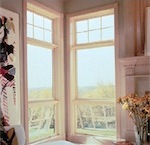Choosing the right light bulb could drastically reduce your power bills and positively affect the environment, but with so many light bulb options on the market, knowing which one to choose can be difficult. Below is a simple comparison between incandescent, compact fluorescent (CFL) and light-emitting diode (LED) to help you decide which is right for you.
Efficiency
There’s been a lot of buzz lately about both compact fluorescent and LED lighting in homes. In fact, a recent survey found that 74% of US households have at least one energy efficient light source in them. Did you know that older incandescents, or traditional light bulbs are only 10% efficient?1 Meaning that only 10% of the electricity they use is transferred into light and the rest is turned into heat. From a cost standpoint this is not a very efficient way to light your home. Luckily, people have started to realize that energy efficiency is the wave of the future and if they want to save money on their electricity costs and help save the planet, they have to make some changes around their home. Now more than ever LED and CFL’s are available everywhere you shop, even in most grocery stores. Making the transition from outdated incandescents to LED’s and CFL’s easy.
LED Lighting: Cost Factors
When lots of individual LED diodes are put together, they can provide quite a bit of light very efficiently. Unfortunately, with the amount of individual LED’s that are needed to replace more conventional light sources, high quality LED fixtures can become cost-prohibitive for the average household. They initially cost about 50x more than an incandescent light bulb but they last approximately 100 times as long as an incandescent bulb meaning that during the lifespan of an LED style bulb, you would have bought 100 incandescent bulbs. That’s a lot of light bulbs!
CFL Lighting: Cost Factors
CFL lights are the ones you see in every store nowadays. They are easy to find and cheaper than LEDs. They are a great replacement for your traditional incandescent bulb. They come in many styles and shapes including the spiral shape and the globe.
If you compare these to incandescent bulbs, CFLs are approximately four times as efficient because a 25 Watt CFL bulb will have the same light output as a 100 Watt incandescent. They will last approximately 10 times longer as well-during the life of a standard CFL, you would have used 10 incandescent bulbs. Again, that’s a lot of light bulbs!
So if you are comparing based on cost, you will have to examine whether you have the money to retrofit all or some of your home upfront. A CFL has a higher purchase price than an incandescent but can save over five times its purchase price in electricity costs over the lamp’s lifetime. If you want to use CFLs this can be expensive upfront but as you can see, the long term cost savings based on life span and energy efficiency are enormous.
Cost Factor Comparison
| BULB TYPE | Life Span Of Light | Quality Of Light |
|---|---|---|
| Incandescent | Short | Fair |
| CF | Long | Excellent |
| LED | Very Long | Good |
On the subject of price, in most situations, the CFL would also be a better choice over the LED. It’ll consume essentially the same amount of electricity, and even though it has a shorter lifespan, even if you replaced the CFL three times to achieve an equivalent lifespan to the LED, you’d still have only spent $2.58 in comparison to the LED’s $45 initial purchase price. As a side note, lighting industry experts expect the price of CFL’s to increase over the next few years due to a shortage of rare earth oxides. However, even with these increases, in many instances CFL’s will still be cheaper to purchase than LEDs.
LED Lighting: Lighting Factors Comparision
LEDs are just about everywhere: on your mobile phone, in your television remote and lighting up the buttons on the front of your DVD player. LEDs are so popular for these applications because they’re very efficient at converting energy to light on and they have a very long lifespan. As we went over above a single LED light is not adequate to light rooms in a home, you would need many diodes combined to make up a light source for a room. You can use these well with dimmers; they can brighten and dim very well. They will also work well with most timers. Sometimes with the cheaper of these bulbs, instead of going completely off, LEDs will glow slightly due to the small amount of current that LEDs require to illuminate. This could be irritating to some consumers, but this technology is still in its infant stages and you can expect that with time and research this product will improve greatly.
CFL Lighting: Lighting Factors Comparison
Compared to incandescents giving the same amount of visible light, CFLs use less power (one fifth to one third) and have a longer rated life (eight to fifteen times)2. CFLs radiate a light spectrum that is different from that of incandescents. Improved phosphor3 formulations have improved the perceived color of the light emitted by CFLs, and some sources rate the best “soft white” CFLs as similar in color to standard incandescents. If you are looking for a way to light your home that is similar to the way your “old lightbulb” used to, this is the way to go.
Lighting Factors Comparison
| BULB TYPE | Energy Efficiency | Initial Cost |
|---|---|---|
| Incandescent | Poor | Poor |
| CFL | Excellent | Excellent |
| LED | Excellent | Good |
The characteristics above pertain to the general and most commonly used types of each light source. There are poor, good, better, and best, within each technology. Good technology poorly deployed can produce a poor result. Fair technology well deployed can produce a great result. Consult with your lighting professional for a well-designed solution and technology choice for your application.
Hopefully, this has been able to show you the differences in light quality and cost a consumer can expect to decide upon when shopping for these newer types of bulbs. Not only are these bulbs great for energy efficiency, they are also becoming more and more pleasing to the eye with less “warm up” time or displeasing flickers.
Danielle Stewart writes for Precision Paragon, an energy efficient commercial LED lighting manufacturer and an expert in industrial lighting retrofits.









With this good detailed comparison between CFL and LED lights,this will help to decide which is the better choice.
I have my house wired with X10 light controllers, so CFL’s are a real plobrem for me.I’m intriqued by L.E.D. lighting, as it seems it might be a better fit for my switches. I’ve actually replaced most of the lights in my house with dimmable CFL’s and cold cathode bulbs which are rediculously expensive. This was a few years ago. Dimmable CFL’s take a long time to heat up and get to full brightness, and they are not as reliable in X10 circuits as incandescent. (I used to work for X10, and they make complete crap, so sometimes you have to work with the stuff to get it to work properly but with patience, they are capable of working fairly reliably).I’ve heard to stay away from LED for X10 but things may have changed since I heard that advice. I do have some CREE flashlights, and those LEDs are amazing, so I can imagine they might perform pretty well.You have to pay close attention with the calculator on that site, because it lists incandescent bulbs at $5.40, with a life of 2000 hours. Real light bulbs are much cheaper than and last more like 5000 hours, so the calculations are not accurate. Also, without having seen one, I don’t know if a 12 watt LED is a good direct replacement for a 65 watt bulb, or a 100, or a 40, but when I put in 40 (with 0 cost for the fixture, because I already own it), it was saying it would take on the order of 8 years to pay for itself at which time, realistically, you might expect a fairly good likelihood that some of the LED filiments, or even possibly the driver have failed (the LED’s have multiple filaments, so more likelihood of failure and the driver circuit may also fail). In the real world, its going to take much longer to pay for them but I think as they become more widely used, the price will go down and they’ll be less Mercury in cans of Albacore Tuna too